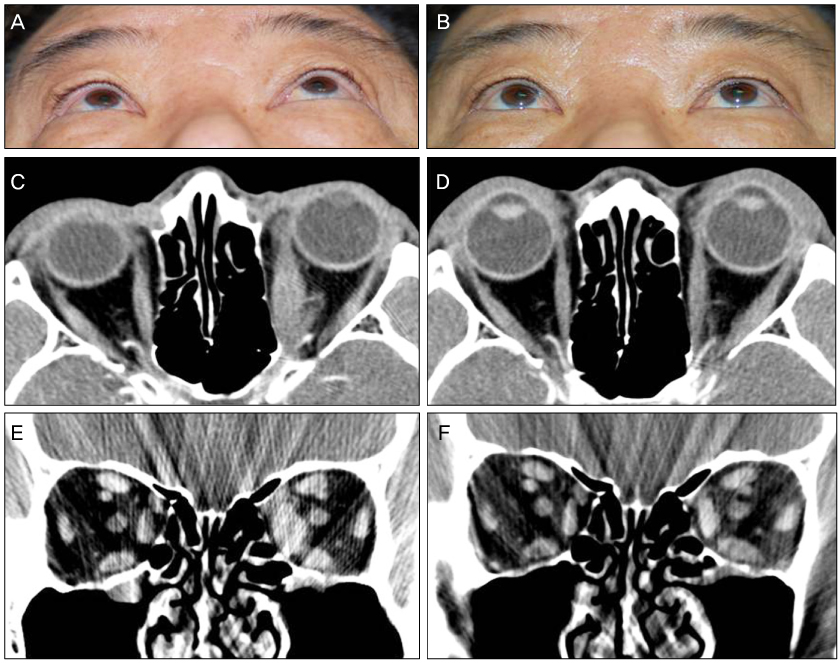J Korean Ophthalmol Soc.
2012 May;53(5):721-727.
Three Cases of Rituximab Treatment for Orbital Inflammatory Disease
- Affiliations
-
- 1Department of Ophthalmology, Dongkang Medical Center, Ulsan, Korea.
- 2Department of Ophthalmology, Samsung Medical Center, Sungkyunkwan University School of Medicine, Seoul, Korea. ydkimoph@skku.edu
Abstract
- PURPOSE
To report three cases of rituximab treatment in refractory orbital inflammatory disease.
CASE SUMMARY
Rituximab treatment was performed in three patients (thyroid-associated ophthalmopathy, orbital myositis, and idiopathic sclerosing inflammation) unresponsive to corticosteroid and radiotherapy. One cycle consisted of intravenous infusion of 1000 mg of rituximab, twice at a two-week interval. The patient with thyroid-associated ophthalmopathy exhibited clinical improvement in visual acuity, color vision, visual evoked potential, and visual field after one cycle of rituximab treatment. The patient with orbital myositis improved showed diplopia with a decrease in the size of the extraocular muscle after two cycles of treatment. The patient with idiopathic sclerosing inflammation showed improvements in visual acuity and visual field defect after one cycle of therapy. There were no severe infections or hematologic adverse effects including neutropenia, or decreased immunoglobulin during the follow-up period.
CONCLUSIONS
Treatment with rituximab appears to offer another therapeutic option in patients unresponsive to corticosteroid or radiotherapy.
Keyword
MeSH Terms
-
Antibodies, Monoclonal, Murine-Derived
Color Vision
Diplopia
Evoked Potentials, Visual
Follow-Up Studies
Graves Ophthalmopathy
Humans
Immunoglobulins
Inflammation
Infusions, Intravenous
Muscles
Neutropenia
Orbit
Orbital Myositis
Visual Acuity
Visual Fields
Rituximab
Antibodies, Monoclonal, Murine-Derived
Immunoglobulins
Figure
Reference
-
1. Lutt JR, Lim LL, Phal PM, Rosenbaum JT. Orbital inflammatory disease. Semin Arthritis Rheum. 2008. 37:207–222.2. Tsokos GC. B cells, be gone--B-cell depletion in the treatment of rheumatoid arthritis. N Engl J Med. 2004. 350:2546–2548.3. Pescovitz MD. Rituximab, an anti-cd20 monoclonal antibody: history and mechanism of action. Am J Transplant. 2006. 6(5 Pt 1):859–866.4. Smolen JS, Keystone EC, Emery P, et al. Consensus statement on the use of rituximab in patients with rheumatoid arthritis. Ann Rheum Dis. 2007. 66:143–150.5. El Fassi D, Nielsen CH, Hasselbalch HC, Hegedus L. The rationale for B lymphocyte depletion in Graves' disease. Monoclonal anti-CD20 antibody therapy as a novel treatment option. Eur J Endocrinol. 2006. 154:623–632.6. Kurz PA, Suhler EB, Choi D, Rosenbaum JT. Rituximab for treatment of ocular inflammatory disease: a series of four cases. Br J Ophthalmol. 2009. 93:546–548.7. Harris GJ. Idiopathic orbital inflammation: a pathogenetic construct and treatment strategy: The 2005 ASOPRS Foundation Lecture. Ophthal Plast Reconstr Surg. 2006. 22:79–86.8. Yuen SJ, Rubin PA. Idiopathic orbital inflammation: distribution, clinical features, and treatment outcome. Arch Ophthalmol. 2003. 121:491–499.9. Rubin PA, Foster CS. Etiology and management of idiopathic orbital inflammation. Am J Ophthalmol. 2004. 138:1041–1043.10. Hougardy DM, Peterson GM, Bleasel MD, Randall CT. Is enough attention being given to the adverse effects of corticosteroid therapy? J Clin Pharm Ther. 2000. 25:227–234.11. Silkiss RZ, Reier A, Coleman M, Lauer SA. Rituximab for thyroid eye disease. Ophthal Plast Reconstr Surg. 2010. 26:310–314.12. Kazlow Stern D, Tripp JM, Ho VC, Lebwohl M. The use of systemic immune moderators in dermatology: an update. Dermatol Clin. 2005. 23:259–300.13. Nash PT, Florin TH. Tumour necrosis factor inhibitors. Med J Aust. 2005. 183:205–208.14. Ho VH, Chevez-Barrios P, Jorgensen JL, et al. Receptor expression in orbital inflammatory syndromes and implications for targeted therapy. Tissue Antigens. 2007. 70:105–109.15. Nielsen CH, El Fassi D, Hasselbalch HC, et al. B-cell depletion with rituximab in the treatment of autoimmune diseases. Graves' ophthalmopathy the latest addition to an expanding family. Expert Opin Biol Ther. 2007. 7:1061–1078.16. Takemura S, Klimiuk PA, Braun A, et al. T cell activation in rheumatoid synovium is B cell dependent. J Immunol. 2001. 167:4710–4718.17. Vos K, Thurlings RM, Wijbrandts CA, et al. Early effects of rituximab on the synovial cell infiltrate in patients with rheumatoid arthritis. Arthritis Rheum. 2007. 56:772–778.18. Hasselbalch HC. B-cell depletion with rituximab-a targeted therapy for Graves' disease and autoimmune thyroiditis. Immunol Lett. 2003. 88:85–86.19. Salvi M, Vannucchi G, Campi I, et al. Efficacy of rituximab treatment for thyroid-associated ophthalmopathy as a result of intraorbital B-cell depletion in one patient unresponsive to steroid immunosuppression. Eur J Endocrinol. 2006. 154:511–517.20. Salvi M, Vannucchi G, Campi I, et al. Treatment of Graves' disease and associated ophthalmopathy with the anti-CD20 monoclonal antibody rituximab: an open study. Eur J Endocrinol. 2007. 156:33–40.21. Khanna D, Chong KK, Afifiyan NF, et al. Rituximab treatment of patients with severe, corticosteroid-resistant thyroid-associated ophthalmopathy. Ophthalmology. 2010. 117:133–139.e2.22. El Fassi D, Banga JP, Gilbert JA, et al. Treatment of Graves' disease with rituximab specifically reduces the production of thyroid stimulating autoantibodies. Clin Immunol. 2009. 130:252–258.23. Schafranski MD. Idiopathic orbital inflammatory disease successfully treated with rituximab. Clin Rheumatol. 2009. 28:225–226.24. Smolen JS, Keystone EC, Emery P, et al. Consensus statement on the use of rituximab in patients with rheumatoid arthritis. Ann Rheum Dis. 2007. 66:143–150.25. Emery P, Fleischmann R, Filipowicz-Sosnowska A, et al. The efficacy and safety of rituximab in patients with active rheumatoid arthritis despite methotrexate treatment: results of a phase IIB randomized, double-blind, placebo-controlled, dose-ranging trial. Arthritis Rheum. 2006. 54:1390–1400.26. Edwards JC, Szczepanski L, Szechinski J, et al. Efficacy of B-cell-targeted therapy with rituximab in patients with rheumatoid arthritis. N Engl J Med. 2004. 350:2572–2581.27. Dunleavy K, Hakim F, Kim HK, et al. B-cell recovery following rituximab-based therapy is associated with perturbations in stromal derived factor-1 and granulocyte homeostasis. Blood. 2005. 106:795–802.28. Edwards JC, Leandro MJ, Cambridge G. B lymphocyte depletion therapy with rituximab in rheumatoid arthritis. Rheum Dis Clin North Am. 2004. 30:393–403. viii
- Full Text Links
- Actions
-
Cited
- CITED
-
- Close
- Share
- Similar articles
-
- Rituximab Treatment for Neuroimmunologic Disorders
- Rituximab in Patients with Inflammatory Myopathies
- The Clincal Experiences of the Orbital Pseudotumor
- Effect of Gangliosides Mixture on Differentiation of Orbital Fibroblasts into Adipocytes
- Effect of Corticosteroid on Orbital Pseudotumor Caused by Orbital Myositis




